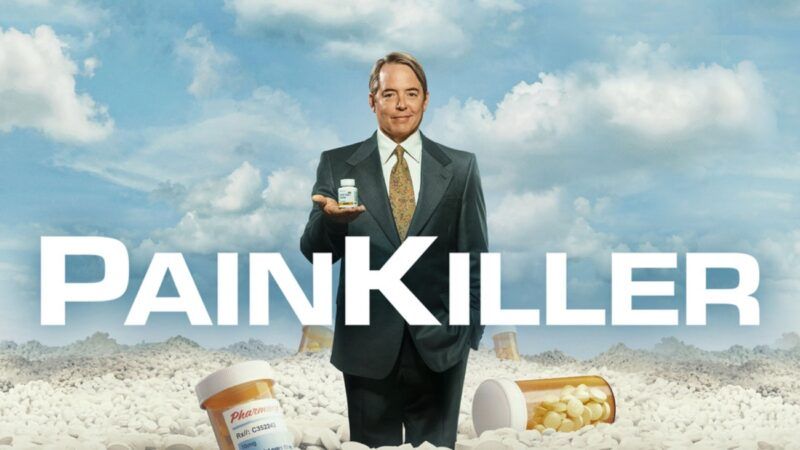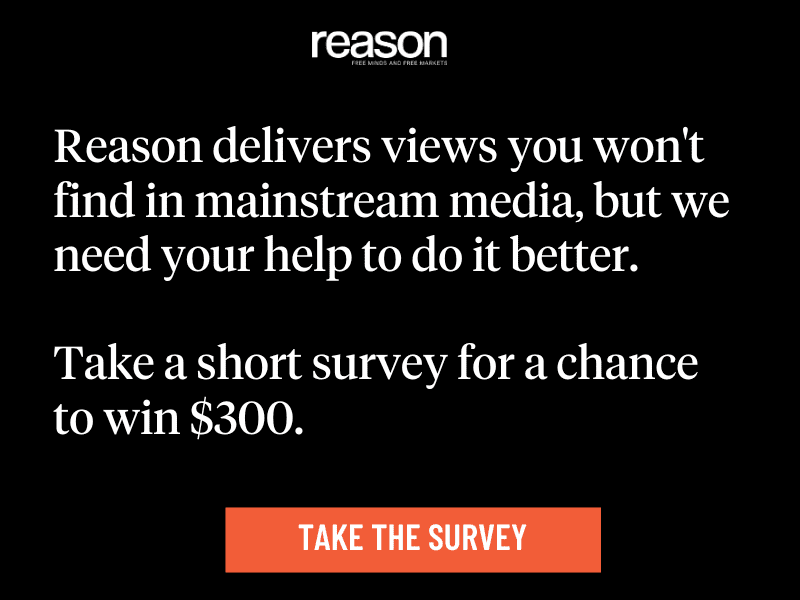A Netflix Drama Reinforces Pernicious Misconceptions About Pain Treatment
Painkiller reflects an indiscriminate anti-opioid bias that has caused needless suffering.

Former New York Times reporter Barry Meier, whose book about OxyContin is the main basis for the Netflix drama Painkiller, acknowledges that the drug is "valuable for treating severe pain caused by cancer or chronic health issues." The problem, he says, was that OxyContin's manufacturer, Purdue Pharma, "could only make billions from it by lying, by saying it was good for everyday, common pain."
Netflix's six-part miniseries highlights that second point, vividly portraying Purdue Pharma's reckless marketing of OxyContin. But it dismisses the caveat: that there are legitimate medical uses for this drug and other prescription opioids, which can make life bearable for patients who otherwise would suffer from excruciating pain.
Like the 2022 Hulu drama Dopesick, Painkiller embraces an indiscriminate aversion to opioids. The same attitude has inspired ham-handed restrictions on pain medication, which have helped drive drug-related deaths to record levels while leaving millions of patients to suffer needlessly.
Although Meier's take on opioids is more nuanced than the one presented by this adaptation of his book, he shares with the screenwriters a desire to pin a complex, long-running social problem on a single villain. That much is clear from the subtitle of his book: "An Empire of Deceit and the Origin of America's Opioid Epidemic."
As Meier's former employer frequently puts it, OxyContin is "widely blamed" for "igniting the opioid crisis." But is it rightly blamed?
OxyContin, which was introduced in 1996, is an extended-release version of oxycodone, a semisynthetic opioid that had long been available in products such as Percocet and Percodan. OxyContin contained a larger dose of oxycodone, which was supposed to be gradually released over a 12-hour period, such that a patient could obtain steady pain relief by taking two pills a day.
That safeguard, according to labeling approved by the Food and Drug Administration, was "believed" to reduce the drug's abuse potential. As it turned out, the original design could be readily defeated by crushing the tablets and snorting the powder.
According to federal survey data, however, nonmedical use of prescription pain relievers rose for 11 consecutive years before OxyContin was introduced. And regardless of how appealing it may have been to drug users, OxyContin never accounted for a very large share of the opioid analgesic market.
During litigation, Purdue presented data indicating that OxyContin accounted for just 3.3 percent of pain pills sold in the United States from 2006 through 2012. After adjusting for potency, ProPublica calculated that the product's "real" market share was more like 16 percent.
OxyContin likewise accounted for a relatively small share of nonmedical use: about 17 percent in 2009, the year before it was reformulated. It is hard to reconcile these numbers with the idea that OxyContin was "the origin of America's opioid epidemic."
If Painkiller merely exaggerated the impact of one product, we might chalk it up to dramatic license. But because this product is not qualitatively different from other opioid analgesics, Painkiller's indictment of OxyContin amounts to an indictment of the whole drug category.
The episodes are introduced by grieving parents who tell true stories about deadly addictions, some of which involved patients who received OxyContin prescriptions. But such outcomes are far from typical.
Among patients who use opioids for chronic pain, according to a 2016 research review in The New England Journal of Medicine, "rates of carefully diagnosed addiction" averaged less than 8 percent. The authors concluded that "addiction occurs in only a small percentage of persons who are exposed to opioids—even among those with preexisting vulnerabilities." In 2021, a California judge who examined the relevant evidence likewise estimated that the addiction rate is "less than 5%."
Painkiller aims to stoke outrage at clueless doctors who carelessly prescribed OxyContin because they believed Purdue's hype. Yet the misconceptions it reinforces have resulted in a different sort of outrage, reflected in the headline above a recent New York Times video: "They Live in Constant Pain, but Their Doctors Won't Help Them."
© Copyright 2023 by Creators Syndicate Inc.
Editor's Note: As of February 29, 2024, commenting privileges on reason.com posts are limited to Reason Plus subscribers. Past commenters are grandfathered in for a temporary period. Subscribe here to preserve your ability to comment. Your Reason Plus subscription also gives you an ad-free version of reason.com, along with full access to the digital edition and archives of Reason magazine. We request that comments be civil and on-topic. We do not moderate or assume any responsibility for comments, which are owned by the readers who post them. Comments do not represent the views of reason.com or Reason Foundation. We reserve the right to delete any comment and ban commenters for any reason at any time. Comments may only be edited within 5 minutes of posting. Report abuses.
Please to post comments




I'm making $90 an hour working from home. I never imagined that it was honest to goodness yet my closest companion is earning 16,000 US dollars a month by working on the connection, that was truly astounding for me, she prescribed for me to attempt it simply.
Everybody must try this job now by just using this website... http://www.Payathome7.com
I started watching this. It is unclear to me what Purdue's actual crime was. Everyone knew it was an opiate, an opiate greater in potency than morphine. What do those people in chronic pain do for pain now?
Suffer.
We suffer. Actually we are told to get anti-depressants so the pain doesn't get us down. In other words don't relieve the problem just get a drug so you don't feel so bad about the pain.
After a wicked car wreck involving breaking my back in multiple spots along with various other injuries causing chronic pain I know all too well about this...I've had more than one supposed 'pain doctor' try to prescribe me anti-depressants apparently thinking my pain is more psychological than physical (check the MRI anyone?) and more than once been left to withdraw cold turkey from oxycodone because my dr decided not to renew the script I'd had for years prior...it's crazy nowadays how doctors are so opiate-averse even with patients who have been taking them for years with no issues but I suppose it's the lawyers that get the say over who gets what meds not the actual medical professionals
The truth and the narrative seldom coincide.
It is just crazy. Oxycontin has reached mythical status at this point. I have been in pain management for years. Due to the frequent drug shortages, I had to switch medicines. Which in and of itself is a hassle. However, with my insurance, Oxycontin wasn't an option. They will cover the new "abuse deterrent" version if you jump through hoops and swear nothing else works for you. But since that one costs five times as much as all the other ones, they would prefer you didn't. However, on the list of approved drugs; is an analogue of Oxycodone, the main ingredient of Oxycontin. An analogue that is twice as strong. However, the strength doesn't really matter. The strength only affects the dose you take. All commercially available opiates basically have the same range of doses available. If a drug is twice as strong, you are prescribed a dose half as much. When prescribed properly, the drug really doesn't matter per se. Since people are never the same, some drugs work differently for some people. As I told my doctor, the new medicine is different. Has slightly different side effects and its method of action is slightly different; but in the end it does the same thing. But the moral panic over Oxycontin means that I am now prescribed a drug that is twice as strong. Talk about unintended consequences. In an effort to curb drug use, they are now funneling people into stronger drugs. I think stupidity mixed with moral outrage is probably the strongest drug their is.
That's disappointing to hear. I was looking forward to another show featuring the "Friday Night Lights" team of showrunner Peter Berg and Taylor Kitsch (aka "Tim Riggins").
I hope the dumb shit medical authorities who are restricting Oxy get back problems, gout, etc. so they can understand what chronic pain is like.
Given how plentiful Fentanyl is, I doubt there are many druggies bothering to get a prescription for Oxy.
Everytime some douchebag filmmaker shows painkillers in a negative light it becomes difficult for people with legitimate needs to get effective pain medicine.
Actually the “prescription panic” was probably seen as an easy win for the DEA. DEA has never yet prevented or stopped what might reasonably be considered a drug epidemic. Think weed in the 70’s, powder cocaine in the 80’s and 90’s, crack cocaine in the 80’s, heroin ever. They’ve been unable to justify their budgets all this time with interdiction of Schedule I illicit drugs (or hoping no one will notice these failures). So they hopped right on the prescription pain meds panic because they could 1) control the amounts of Schedule II meds being manufactured or imported; and 2) can scrutinize your doctor’s prescribing decisions and your pharmacist’s sales; and 3) can come down hard if they see something their lawyers regard as improper. The only drawback to this scheme is that they can’t invoke civil forfeiture rules as often and need to keep their money faucets running by constantly reinforcing the idea of the prescription epidemic. i don’t know of any federal or state legislators who will take the huge political risk of looking at the actual data and speaking out in support of rational, scientific, and compassionate medical approaches to pain.
By the way, if you have some time look at the list of fentanyl analogues and other current or potential substitutes and adjuvants, that can be used to juice up whatever's being sold as street "heroin" in any given time and place. DEA will have to juice up their own police state methods to have any hope at all of managing all of that. That's not going to happen, we can hope, and we need to continue to speak up about the successful harm reduction policies adopted in Portugal and other European countries.
It wasn't the, "Perdue Hype," as much as the, "Babe's Benefits."
Hi we are https://www.senatelabs.com/ Third party Manufacturer Pharmaceutical company Near Roorkee. Senate Laboratories in India is an internationally recognized WHO-GMP certified and one of the leading contract third party manufacturing pharmaceutical company. Senate Laboratories has rapidly emerged as the premier integrated pharmaceutical company in India. Its business focus is on manufacturing & marketing of pharmaceutical products along with serving clients across the globe.
“Senate Laboratories”, has achieved tremendous growth as most efficient manufacturer and supplier of high quality and safe to use Pharmaceutical Products. Due to our processing knowledge, we offering Pharmaceutical Tablets, Capsules, Syrup, Ointment, Liquid & Dry Injection. We have gained huge appreciation and acceptance in their market because we believe in providing only genuine products that are prepared from lab examined chemicals. Thus with these prospects, our offered medicines are known for high effectiveness, precise formulation and excellent finishing. We have been widely appreciated by our clients as dependable business partner, which can guide them in the consumer markets with expertise and tenacity. We are a customer centric organization which can be clearly seen from the long term relations that we have established with our clients.